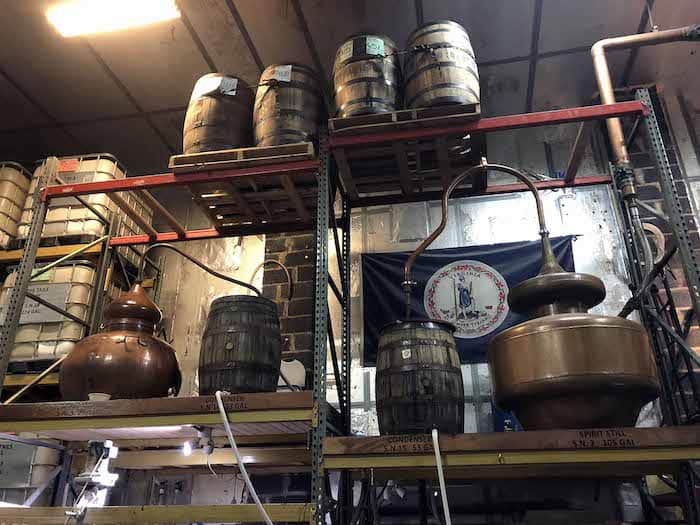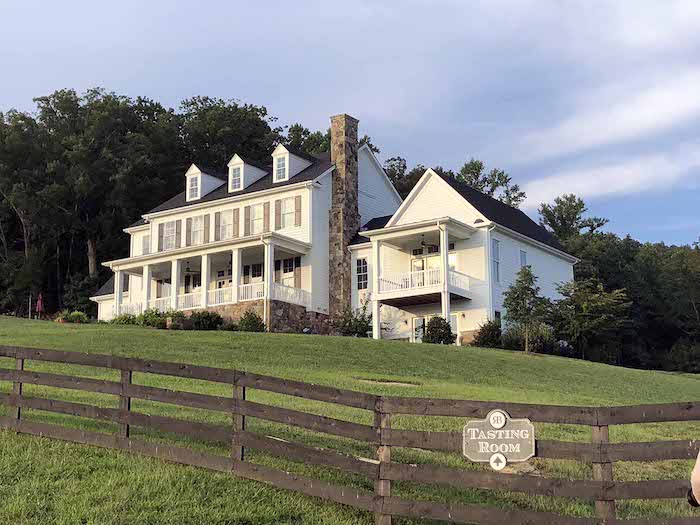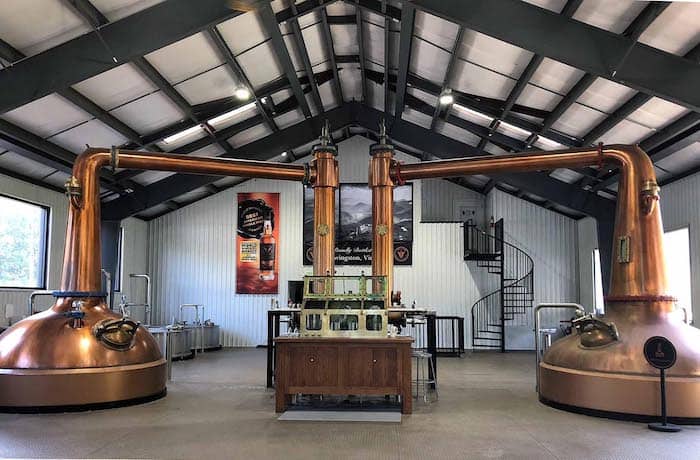The bumper-sticker slogan, “Virginia is for Lovers” is touted by the commonwealth’s tourism folks as so successful that they’ve used it for four decades. But following my three-day trek across much of east Virginia last August, it could be revised to read “Virginia is for Craft Spirits Lovers.
A handful of reporters and I experienced that truth firsthand at a bunch of distilleries where we tasted a lot of fine spirits and talked up a slew of great distillers.
The enthusiasm for Virginia craft distilling is infectious. Virginia boasts, at the time of this article being published, over 60 licensed craft distilleries, and more are on the way. Among the notables producing whiskey here are George Washington’s historic Mount Vernon distillery; the award winning John J. Bowman Distillery; the modern and expansive malt-whiskey-making Virginia Distillery Co. and the Belmont Farm Distillery (seen on TV series “Moonshiners”).
But mentions of those don’t scratch the surface of the full range of producers and their wide range of products. Our group visited just seven distilleries before finishing our trip at an event featuring sips provided by an additional 15.
A simple look at the variety of what’s produced here from when I did my tour:
- 38 of 63 produce barrel-matured whiskey, whisky, rye, bourbon or single malt
- 25 of 63 produce moonshine and/or white whiskey
- 25 of 63 produce gin
- 18 of 63 produce rum
- 16 of 63 produce vodka
- 10 of 63 produce brandy
- 9 of 63 produce other (e.g., various liqueurs, aquavit, absinthe, etc.)
To detail the trip in this limited space is impossible, so I’ll stick to the highlights and what spirits are recommended purchases if you go there or can buy their goods online. The following list is in order of our travel itinerary.
Cactoctin Creek Distillery, Purcellville, Va.
Owners: Scott and Becky Harris. Before opening, he was a computer engineer; she was a chemical engineer. Today, he runs the business and she runs the stills. The result is a line of delicious rye whiskeys, brandy and gin. (Check out this video profile of the Harrises.)
Liquor particulars: Their four regular rye releases, ranging from 80 proof to cask strength, are designed to resemble rye whiskies of the 1800s: grain forward, rounder edges and leaner mouthfeel. (Click here to see the full lineup)
Fun note: Becky Harris ages her whiskeys in 30 gallon barrels “because that’s the largest barrel I can move on my own.” All are No. 3 char. Fifty-three gallon barrels are in future plans.
Sad note: Due to U.S. tariffs imposed on the E.U. last July, and the subsequent retaliatory tariffs imposed by the E.U., 25 percent of Catoctin’s whiskey revenue disappeared.
KO Distilling, Manassas, Va.
Owners: Bill Karlson and John O’Mara are the “K” and the “O” in KO Distilling. They met at the United States Merchant Marine Academy and later had careers in defense contracting. The answer to their, “What’s next?” post-retirement question was launching a distillery in 2015. (Check out this video profile of Karlson and O’Mara.)
Liquor particulars: Two lines: Bare Knuckle Single Barrel Whiskey (Straight Wheat, Straight Bourbon and Straight Rye); and Battle Standard 142 Gin (Standard, Navy Strength, Barrel Finished). Like KO’s founders, none of its spirits are shrinking violets. Proofs on its whiskeys are all in the 120s. As the pugilistic name implies, some punch you in the face, albeit flavorfully so. These whiskeys are young, and time will smooth their edges. Its gins are robust, yet sippable, botanically diverse and made for cocktails.
Nerd notes: After producing began with just 220 barrels of whiskey a year with its potstill, “Ginny,” owners got a second Vendome still, “Skinny,” to quadruple production to 880 barrels.
Fun note: Though the men readily attracted investment partners, the toughest sale was their wives, who’ve since warmed to the distilling business.
Copper Fox Distillery, Sperryville, Va.

Owner: Rick Wasmund opened this rustic distillery in 2005 with the desire to malt grain in-house just as he learned to at Bowmore Distillery in Scotland. After days of hand raking, wetting and drying, he smokes the malted Virginia barley and rye over a wood fire smoldering in a Weber Kettle grill. Smoke rises from the grill through a screened floor one story above it to accent the malt.
Liquor particulars: Copper Fox produces a wide range of small-count releases, so many, in fact, that whiskeys we tasted in August are not reflected on its website in March. (Click here for the current lineup.) That varied range also reflects Wasmund’s creative and experimental streak that includes steeping fruit wood chips and chunks in whiskeys aging in barrels.
Nerd notes: Wasmund said, “I wanted to do fruit-wood barrels, but fruit wood grain is bad for staves.” The flavor nuances gained make his whiskeys one-of-a kind offerings, as well as ideal gateway sippers for newcomers to single malt spirits. (Check out this video profile of Wasmund.)
Belmont Farm Distillery, Culpepper, Va.
Owners: Chuck and Jeanette Miller and their children have operated this farmstead distillery for three decades “as a low-budget operation … picking from any junkyard I can find,” according to Chuck. The operation’s cobbled-together pattern is part of its charm, however.
Liquor particulars: Belmont has a long line of white whiskeys, flavored moonshines and aged spirits. (Click here to see the lineup.) Some of its more interesting offers include its Kopper Kettle Virginia Whiskey, a three-grain grain whiskey that’s soaked for two months with charred Virginia white oak and Virginia apple wood, then aged four years in oak barrels. The 92 proof Virginia Straight Bourbon Whiskey is also quite good, even at two years. I’d like to revisit at four.
Nerd notes: Using its 3,000-gallon pot still, many Belmont spirits are stripped at 75 proof and then doubled to 150 proof.
Fun notes: Tim Smith, the distillery who “went legit” on the TV series “Moonshiners,” did so at Belmont under the tutelage of Chuck Miller. His Climax Moonshine is made there. (Check out this video profile of the Miller family.)
Ragged Branch, Charlottesville, Va.

Owner: Alex Toomy is a jack of many trades who’s mastered several of them, including high-end home building. But, after the housing crisis of 2007-’09, Toomy and some business partners thought it wise to find another income stream. They settled on whiskey distilling and built a still house and rickhouse just outside of Charlottesville. The goal was to make two bourbon products: one accented with rye, the other with wheat. “Keep it simple, make it great,” Toomy said. “We grow all our own grain except for barley.” All spent mash is fed to a small angus cattle herd on the campus, and that herd’s beef is sold out of its visitor’s center.
Liquor particulars: The rye bourbon is aged two years, while the wheated bourbon rests for four years. Both are really well made and highly flavorful. A straight rye whiskey is in the works.
Fun fact: The visitors center and tasting room is a 6,000 square-foot home Toomy built, but struggled to sell. Since he owned it, he converted it to Ragged Branch’s operations. Beautiful as it is, “My favorite building ever is this barrel house,” Toomy said. “I think it’s just really cool.”
Nerd notes: Ragged Branch whiskey is run once–no stripping run–over a five-plate hybrid pot still. Rye bourbon comes off at 145, wheated at 135, and both are barreled at 125.
Virginia Distillery Co., Lovingston, Va.

Owners: Angela Moore, her son Gareth Moore and his wife Maggie Moore are carrying forth the vision of Angela’s late husband, Dr. George Moore, to create American single malt whiskies. (Check out this video profile of Gareth Moore.)
This expansive and thoroughly modern distillery includes two large copper pot stills: one for low wines, the other for high wines finished at 148 proof. Cooperage is used and divided between whiskey, wine, beer, cider, port and Oloroso, PX and sherry fino casks.
Liquor particulars: We sampled several whiskies, including the solid Virginia-Highland port-barrel release, a six-year whisky sourced from Scotland and then rested in port barrels. Delicious. Even better were tastes of fresh-from-the-barrel PX and Oloroso sherry finished whiskies. (Click here to see the full lineup.)
Fun fact: For special guests, a “whiskey cave” was built in one of its warehouses. The space is hidden by ricked barrels and a false door made from half barrels. Built from the ground up with a $14 million investment, this distillery is by far the prettiest we saw. A must visit if you’re in the mood for distillery eye candy.
Nerd notes: The all-barley grain wash is distilled to 100 proof low wines, then distilled to 148 proof high wines. All distillate is barreled at 125 proof and aged in used cooperage.
Reservoir Distillery, Richmond, Va.
Owners: Dave Cuttino and Jay Carpenter use an Armagnac still to make American whiskeys born of Virginia grain. Their industrial tasting room in the city’s downtown abuts the distillery. There are “pretty” distilleries and “gritty” ones. Reservoir is the latter, which is part of its charm, along with its friendly owners.
Liquor particulars: The mash bills for its expressions of wheat, bourbon and rye are 100 percent wheat, corn and rye, respectively. All distillate is aged in 15-gallon barrels (a.k.a. quarter casks). Special releases such as whiskeys made from IPA and stout beers bear amazing reminders of their source materials.
Full truth: I’m not a big fan of whiskies aged in small barrels as my palate picks up notes of dusty, pressed flowers and tannic oak. However, on the bar is a bottle of Reservoir’s bourbon, draped in medals won in multiple high-profile spirits competitions. Somebody clearly loves what these guys are doing, and that’s fine by me. (Click here to see the full lineup.)
Fun fact: Owners describe the tasting room as the world’s most dangerous bar because of multiple high-voltage circuit boxes that make up the back of the bar. Inoperable relics of pre-OSHA days for sure, but they’re admittedly fear-inspiring.
Nerd notes: The tiny distillery’s products are now marketed in 15 states, the U.K. and Sweden. And just as happened at Catoctin, Reservoir saw export sales slump with last summer’s tariffs.








